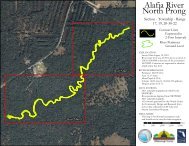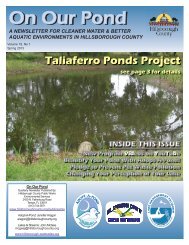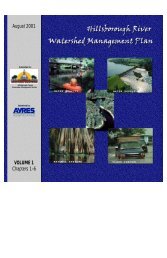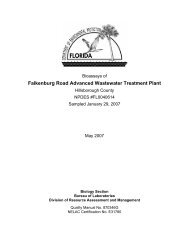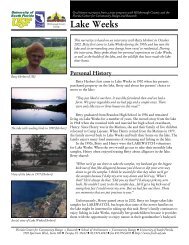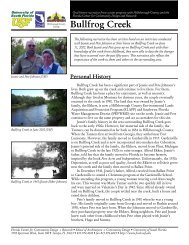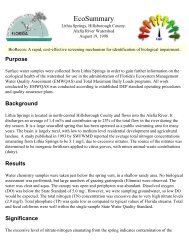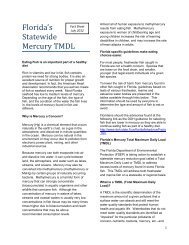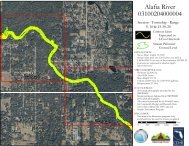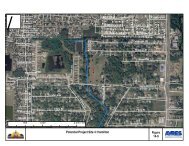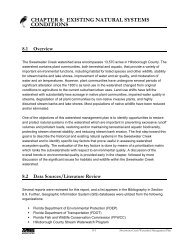EXISTING NATURAL SYSTEMS CONDITIONSshades-out, and displaces native vegetation. The bark, leaves, and seeds are poisonous to farmand domestic animals. Chinaberry is a landscape element on residential properties in thewatershed.Skunk VineSkunk vine, a woody vine from Asia, actually doessmell more-or-less skunk-like. The aggressive,competitive plant may grow high into the trees in avariety of habitats, from mesic hammocks to xericsand hill communities. It appears to prefer sunnyfloodplains and bottomlands, and can even growunder water. Reportedly introduced in 1897 as a"potential fiber crop", skunk vine now occursthroughout the southeastern U.S. Herbarium recordsindicate that skunk vine grows in at least 17 counties of central and north central Florida. Its stemsroot freely. This species is prevalent on the edges of the Stream and Lake Swamp habitat(FLUCFCS 615).Chinese TallowLike melaleuca, the Chinese tallow is a tree that grows andspreads rapidly, is difficult to kill, and tends to take over largeareas by out-competing native plants. Chinese tallow isspreading rampantly in large natural areas, including PaynesPrairie State Preserve near Gainesville, state-owned protectedlands along the St. Johns River. It is a landscape element onresidential property and has escaped into all but the xeric plantcommunities.Brazilian PepperBrazilian pepper is one of the most aggressive of the invasive nonindigenousplants in Florida. It is invading aquatic and terrestrialhabitats, greatly reducing the quality of native biotic communities inthe state. Brazilian pepper is from South America, and was probablyintroduced as an ornamental in the mid 1800s. Since it is not coldhardy, the tree occurs mostly in southern Florida. Brazilian pepperis indigenous to the coast of tropical Brazil, Paraguay, and Argentina (Ewel, 1986). It was presentin Florida in the early 1840's (Barkley, 1944) and was re-introduced into Florida in 1898 (Morton,1978). This plant was once sold as a landscape ornamental because it produced dense masses ofscarlet berries. The species is established in mangrove swamps in the <strong>Rocky</strong> <strong>Creek</strong> and ChannelA estuaries.8-40<strong>Rocky</strong>/<strong>Brushy</strong> <strong>Creek</strong> <strong>Watershed</strong> Management <strong>Plan</strong>
CHAPTER 8Wild TaroThe wild taro is an emergent plant, imported from the Pacific Islands. Itoccurs in and out of water. The leaves can grow to two feet long and aremedium to large in size, arrowhead-shaped with heart-shaped bases. Theyare dark, velvety green, and water repellant. Wild taro leaves are peltate: theleaf stem attaches more-or-less to the middle of the underside of the leaf.Leaf stems grow to four feet tall, and flowers occur in small fingerlike spikes.It is established in backwater areas of <strong>Rocky</strong>/<strong>Brushy</strong> <strong>Creek</strong>.Hydrilla, a submerged aquatic plant, grows rooted in the bottom substrate of quiet reaches of the<strong>Creek</strong> and other freshwater habitats. It escaped from the aquarium trade and is well established instream reaches of <strong>Rocky</strong> and <strong>Brushy</strong> <strong>Creek</strong>s and in some lakes in the watershed. Controlmeasures include chemical treatment and the introduction of the Chinese grass carp, a planteatingfish species.8.5.9.2 Exotic FaunaAn exotic animal is a non-indigenous species introduced to an area either purposefully oraccidentally. Exotic, non-indigenous, invasive species compete with native species for space, food,and ecological niche. Activities to prevent and control invasive animal species that severely impactthe lands and waters of the United States have become a priority for watershed management. Theterm invasive species is defined by the Presidential Executive Order 13112. Known as "exoticinvasive"or "alien-invasive" species, these invasive plants and animals cause vast ecological andeconomic damage, and sometimes, human health impacts in areas that they infest. These specieshave gained a foothold on public and private lands throughout the nation and in other parts of theworld, and range across almost every ecosystem of the country including those found within the<strong>Rocky</strong>/<strong>Brushy</strong> <strong>Creek</strong> watershed. Common methods of introduction include release of pets, escapefrom pet dealers, or intentional introduction for pest control. USGS, FDEP, UF-IFAS, andHillsborough County information on non-indigenous species were reviewed to compile a list ofexotic species that have been observed or reported in the watershed. Some of the exotic animalspecies found in the watershed include: Nine-banded armadillo, Cuban tree frog, Greenhouse frog,and Brown anole. These four species arrived in Florida by natural migration (nine-bandedarmadillo) and by accidental introduction (Cuban tree frog, Greenhouse frog, and Brown anole).Armadillos disturb soils in all habitats, particularly Stream and Lake Swamp, Cypress, and otherwetlands during the dry season. The Cuban treefrog is a voracious predator and will attack anddevour anything smaller than itself, including native frogs, fish, and invertebrates. The greenhousefrog may be replacing native frogs, particularly in south Florida, while the brown anole competes tosome degree with the native Carolina anole (chameleon).8-41<strong>Rocky</strong>/<strong>Brushy</strong> <strong>Creek</strong> <strong>Watershed</strong> Management <strong>Plan</strong>



